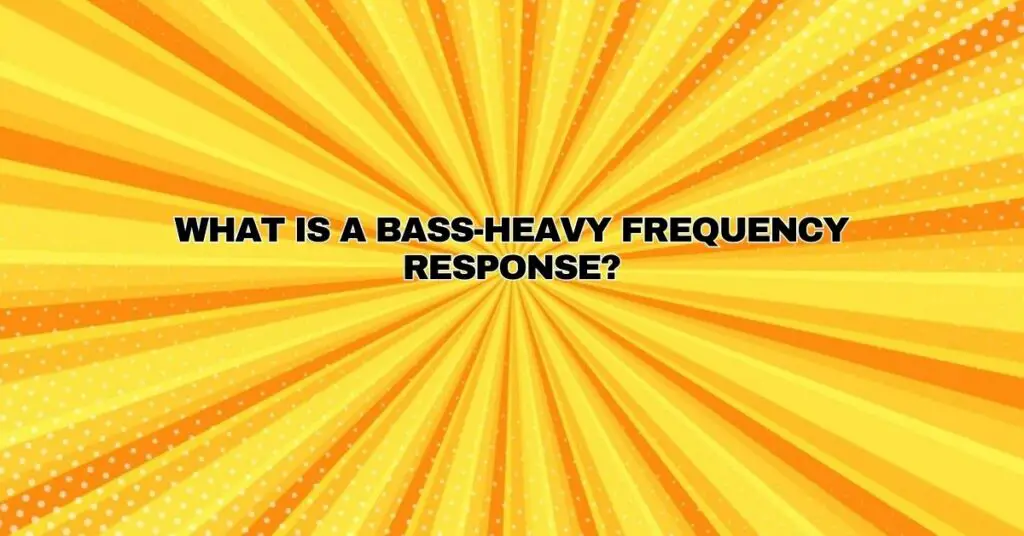Bass-heavy frequency response is a term that resonates with audiophiles, music enthusiasts, and audio engineers alike. It’s the sonic signature that brings the low end of music to life, creating a visceral and impactful listening experience. Achieving a bass-heavy frequency response is a pursuit that involves an understanding of the frequency range, speaker and subwoofer capabilities, room acoustics, and more. In this comprehensive article, we’ll explore the concept of a bass-heavy frequency response, the science behind it, and the practical steps to achieve it for the ultimate audio pleasure.
Understanding Bass-Heavy Frequency Response
A bass-heavy frequency response refers to an audio system or setup that places significant emphasis on the low-frequency range, commonly referred to as the bass. This emphasis results in a powerful and dominant bass presence that not only provides depth to the music but also delivers an immersive and visceral listening experience.
Key Elements of Bass-Heavy Frequency Response:
- Low-Frequency Emphasis: A bass-heavy frequency response places a pronounced emphasis on the lower end of the audio spectrum, encompassing frequencies typically below 100 Hz.
- Impactful Bass: The bass in a system with a bass-heavy frequency response is not only audible but also physically felt. It creates a tactile sensation, making the music or audio content more engaging.
- Enhanced Groove: Bass-heavy systems often contribute to the rhythmic foundation of the music, enhancing its groove and making it more danceable.
The Science Behind Bass-Heavy Response
A bass-heavy frequency response is a product of various acoustic, electronic, and engineering factors:
- Speaker and Subwoofer Design: Speakers and subwoofers used in a system play a significant role. High-quality subwoofers are engineered to reproduce low-frequency sounds accurately and with power.
- Frequency Range: Bass-heavy systems typically operate in the sub-bass and low-bass frequency range, which spans from 20 Hz to approximately 100 Hz. These are the frequencies where the deepest and most impactful bass resides.
- Crossover Settings: In setups with multiple speakers, like home theater systems, the crossover settings determine which frequencies are directed to the subwoofer. Configuring these settings correctly is essential for achieving a bass-heavy response.
- Amplification: Adequate amplification of the low-frequency signals is essential for delivering bass with authority. Subwoofers often have built-in amplifiers optimized for low-frequency performance.
Practical Steps to Achieve Bass-Heavy Response
Here are practical considerations for achieving a bass-heavy frequency response:
- High-Quality Equipment: Invest in speakers, subwoofers, and amplifiers that are designed for low-frequency reproduction. High-quality equipment is essential for achieving powerful and accurate bass.
- Room Acoustics: Room acoustics have a significant impact on bass response. Use bass traps, acoustic panels, and diffusers to manage reflections and resonances in your listening environment.
- Crossover Calibration: If you have multiple speakers, ensure that the crossover settings are correctly configured to allocate the appropriate frequencies to the subwoofer.
- Volume Calibration: Properly calibrate the subwoofer’s volume to balance it with the main speakers. This ensures that the bass response is well-integrated with the rest of the audio.
- Listening Tests: Use reference tracks to evaluate the bass performance of your system. Pay attention to how different music genres and audio content are presented.
- Subwoofer Placement: Experiment with subwoofer placement within the room to achieve the best bass response. Placement can significantly impact the room’s resonances and the perception of bass.
Genres and Bass-Heavy Frequency
The perception of a bass-heavy frequency response can vary based on the type of music or content being played:
- Electronic Dance Music (EDM): In genres like EDM, a pronounced bass presence is integral to the music. These genres often demand deep and impactful sub-bass frequencies, making a bass-heavy system essential.
- Hip-Hop and Rap: Bass-heavy frequencies are a defining feature of hip-hop and rap music. The punchy and resonant basslines are central to these genres.
- Rock and Pop: Even in rock and pop music, a bass-heavy response can enhance the driving force of the music, making it more dynamic and rhythmically engaging.
Conclusion
A bass-heavy frequency response is a sought-after characteristic in audio systems for its ability to create immersive and powerful listening experiences. Achieving this response requires careful consideration of equipment quality, room acoustics, calibration settings, and an understanding of the science behind bass-heavy sound. Whether you’re a music enthusiast looking to feel the groove of your favorite tracks or an audiophile seeking to unlock the full potential of your audio system, a bass-heavy frequency response can breathe life into your audio experiences and immerse you in the world of music like never before.


